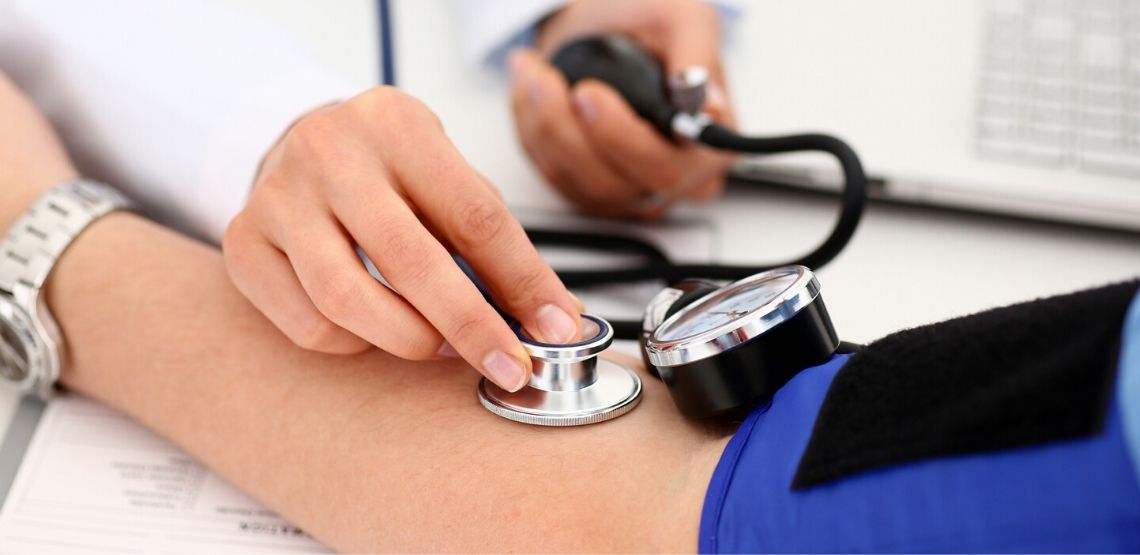What Is Hypertension?
Hypertension, also referred to as high blood pressure (HBP), occurs when the pressure of the blood flow in the arteries is extremely high. It is a medical condition in which the blood pressure (BP) in the arteries is persistently elevated.
HBP occurs when the blood forces a lot of pressure against the walls of the blood vessels. It is a risk factor for heart disease including heart failure, aneurysm, heart attack and stroke. If not treated in time, HBP can cause serious health complications.
Blood pressure is considered high if it is 140/90 mmHg or higher. Keeping BP under control is very important for maintaining good health and reducing the risk of other related conditions, as mentioned above. Blood pressure readings are a combination of two measurements:
- Systolic—usually between 110–130 mmHg
- Diastolic—usually between 70–80mmHg
Causes of Hypertension
Hypertension is divided into two types — primary hypertension (essential hypertension) and secondary hypertension.
Primary Hypertension
There is no known definitive cause for primary hypertension. However, some factors that could be responsible include:
- The absence of any physical activity, exercise and stress (environmental factors)
- Cases of high blood pressure
- Hormone activity in people who manage, regulate and control blood pressure using medication
Secondary Hypertension
Secondary hypertension has specific causes and is a complication of another health problem.
Chronic kidney disease (CKD) occurs when the kidneys lose their ability to filter out fluid, and this causes high blood pressure. This accumulation of excess fluid results in secondary hypertension. Conditions that can lead to secondary hypertension include:
- Diabetes, due to kidney problems and nerve damage
- Kidney disease
- Pregnancy
- Cancer of an adrenal gland (pheochromocytoma)
- Obesity (too much weight that interrupts the flow of blood)
- Corticosteroid drugs that can cause Cushing syndrome
- Disorder of the cortisol-secreting adrenal glands (Congenital adrenal hyperplasia)
- An overactive thyroid gland (hyperthyroidism)
- Hyperparathyroidism, which affects phosphorus and calcium levels
- Sleep apnea
Symptoms of Hypertension
Symptoms of hypertension can include:
- Vision problems
- Sweating
- Jugular vein distention — Dyspnea on exertion
- Chest pain, chest pressure and difficulty breathing
- Accentuated pulmonic valve component (P2)
- Irregular heartbeat
- Tricuspid insufficiency murmur — Hemoptysis
- Blood in the urine
- Prominent right ventricular impulse — Fatigue
- Abnormal findings on chest X-ray or ECG
- Pounding in your chest, neck or ears
- Severe headache
- Right-sided third heart sound (S3) — Anginal chest pain
- Fatigue or confusion
- Hepatomegaly (an enlarged liver) and Peripheral edema (accumulation of fluid causing swelling) — Raynaud’s phenomenon (a medical condition in which some areas of the body feel numb and cool in certain circumstances due to reduced blood flow)
Treatment Options
There are several types of drugs used to treat high blood pressure.
- Calcium channel blockers: including diltiazem (Cardizem and Tiazac) and amlodipine (Norvasc) — normalizes the heart rate and aids in relaxing the muscles of blood vessels.
- Thiazide diuretics: hydrochlorothiazide (Microzide), chlorthalidone and others. Diuretics, also termed as water pills, are drugs that eliminate sodium and water from your kidneys and reduce blood volume; thus, regulating high blood pressure.
- Renin inhibitors: these include Tekturna and the generic name, aliskiren. The release of renin enzyme is slowed down by these inhibitors. Renin is produced by the kidneys and starts a chain of chemical stages that elevate blood pressure.
- Angiotensin: converting enzyme (ACE) inhibitors such as captopril (Capoten), benazepril (Lotensin), lisinopril (Zestril) and others — block the formation of a chemical that narrows the blood vessels and helps relax the blood vessels.
- Beta-blockers: these include acebutolol (Sectral), atenolol (Tenormin) and a few others alleviate the pressure on your heart and widen the blood vessels, which slow down the heart rate using less force.
- Angiotensin II receptor blockers (ARBs): these include candesartan (Atacand), losartan (Cozaar) and others. These prevent the narrowing of blood vessels by blocking the activity of a natural chemical that tightens and narrows the blood vessels.
- Alpha-agonists: these include eplerenone (Inspra) and spironolactone (Aldactone). These medicines prevent the impact of a chemical that causes fluid and salt retention, triggering high blood pressure (hypertension).
- Vasodilators: Hydralazine and minoxidil prevent the muscles in the artery walls from tightening and the arteries from narrowing.
Central-acting agents: guanfacine (Intuniv, Tenex), clonidine (Catapres, Kapvay) and methyldopa.
- Alpha blockers: prazosin (Minipress) and doxazosin (Cardura).
- Alpha-beta blockers: these medications include labetalol (Trandate) and carvedilol (Coreg). These minimize nerve impulses to blood vessels and bring down the amount of blood that needs to be pumped though the vessels.
Home Remedies to Treat High Blood Pressure
Some ways to effectively treat your HBP at-home include:
- Exercise regularly
- Reduce your sodium intake
- Limit your alcohol consumption
- Eat more potassium-rich foods
- Reduce your caffeine intake
- Worry less and adopt stress management techniques
- Lose weight
- Eat dark chocolate or cocoa
Lifestyle Changes for People With High Blood Pressure
A healthy lifestyle is vital to preventing high blood pressure. Several lifestyle changes to be considered include:
- Weight loss
- Limit your alcohol consumption and do not smoke
- Follow the DASH diet — diet comprising of veggies, fruits, low-fat dairy products less saturated fat and less total fat
- Less sodium (less than 1,500 milligrams a day)
- Brisk walking and regular aerobic exercise (at least 30 minutes a day)
